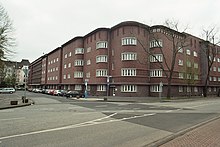Ferdinand Revermann
Ferdinand Revermann (born March 17, 1895 , † 1975 ; full name: Ferdinand Ewald Revermann ) was a German architect .
Life
Revermann completed his studies at the Technical University of Darmstadt . He then worked in shared offices with Georg E. Gobrecht in Wanne-Eickel and Hermann Drüen in Bochum . He designed some notable brick Expressionist and Classical Modern buildings.
After hostility about his architectural style, he joined the NSDAP in 1932 under the influence of a lecture by Paul Schultze-Naumburg . From 1933 to 1938, Revermann, as managing director of the Treuhandstelle subsidiary Bergmannssiedlung Essen GmbH, had residential buildings built in the traditional, down-to-earth style.
In 1938 Revermann was appointed to the town planning officer of Moers . His extensive plans for the urban redesign of Moers city center were not implemented due to the war. Despite the advocacy of well-known citizens in the denazification process after 1945, he was unable to keep the office. After the Second World War he worked again as a private architect with Hermann Drüen and was an active member of the Rugia Darmstadt fraternity .
Revermann was a member of the German Werkbund and the Association of German Architects (BDA).
buildings
- 1926: Housing complex in Wanne , Freisenstrasse 32–46, Lage
- 1926–1928: Sparkasse Wanne-Eickel , in Wanne, Hauptstrasse 224 (with Georg E. Gobrecht) location
- 1927: Ferdinand Wulf's house in Eickel , Reichsstrasse 28 , (with Otto Greiss) location
- 1927: General local health insurance in Eickel, Märkische Straße 11 (with Georg E. Gobrecht) location
- 1927–1929: Housing development for the non-profit Bauverein Essen, so-called Red Block in Wanne, Wanner Strasse 6, 8, 10 and 12, Wibbeltstrasse 7 and 8, Amtmann-Winter-Strasse 5, 7 and 9 (with Georg E. Gobrecht) location
- 1929 Administration Building electricity supply tray-Eickelmann in Eickelmann, main road 89 (manufactured by George E. Gobrecht, after the war destruction 1946 Robert Kaul in reduced forms again) Location
- 1929-1930: Evangelical Paul Gerhardt community center in Bochum - Wiemelhausen , Kuehne 6th place (with Hermann Drüen; demolition of the building heavily modified 2011) Location
- 1938: Expansion of the municipal open-air swimming pool "Bettenkamper Meer" in Moers Lage
- 1939–1940: Fuel settlement of the building association in Moers-Hochstraß, Treibweg Lage
- 1949–1950: Tersteegenhaus (also Gerhard-Tersteegen-Haus , "GTH" for short) in Moers, Haagstrasse 11 Lage
Web links
Individual evidence
- ↑ rp-online.de; Denazification files: Nazi plans for Moers discovered; dated December 23, 2016
- ↑ Figures and brief information on ruhr-bauten.de
- ↑ Figures and brief information on ruhr-bauten.de
- ↑ wanne-eickel-historie.de: The “Red Block” - one of the most important building complexes in the center of Wanner
- ↑ wanne-eickel-historie.de: residential and commercial building Hauptstrasse 89
- ^ BDA district group Bochum (ed.): Architectural guide Bochum. Schürmann & Klagges, Bochum 1986.
- ↑ a b c Entry of the “Gerhard Tersteegen House” in the list of monuments of the city of Moers
- ↑ About us: History. YMCA Moers, accessed January 18, 2014 .
- ^ Jürgen Stock: Monument protection threatens church plans. Rheinische Post , January 8, 2014, accessed on January 18, 2014 .
| personal data | |
|---|---|
| SURNAME | Revermann, Ferdinand |
| ALTERNATIVE NAMES | Revermann, Ferdinand Ewald (full name) |
| BRIEF DESCRIPTION | German architect |
| DATE OF BIRTH | March 17, 1895 |
| DATE OF DEATH | 1975 |



